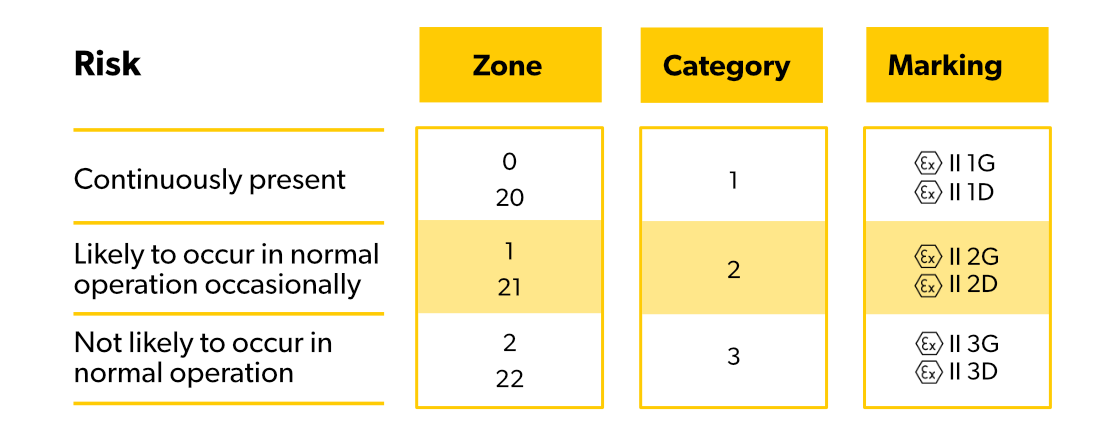For the sake of prevention, protection and legislation, the employer must identify areas where explosive atmospheres may be formed.
Indeed, on July 1, 2003, two directives relating to explosive atmospheres imposed by the European Union came into force, called "ATEX directives". Completed by many other directives and decrees, the ATEX directives are about the identification and delimitation of hazardous areas.
In these zones, no risk must be taken: all equipment used in these areas must be ATEX compliant. These hazardous areas are classified as risk areas according to the frequency and duration of the presence of an explosive atmosphere.
What are the hazardous areas?
The delimitation of zones with a risk of explosion corresponds to the "ATEX zones". ATEX zoning aims to define the risk and to match the equipment to be used with the danger of the zone. The employer must imperatively determine the zones at risk of explosion on a site in the presence of: gas, vapors or dusts.
In accordance with Directive 1999/92/EC and Article R.4227-50 of the Labour Code, there are 3 different levels of ATEX zones for each of the distinctions made: zones with gases and vapors, and zones in the presence of dust.
Zone 0 : Location where an explosive atmosphere consisting of a mixture with air of flammable substances in the form of gas, vapor or mist is present permanently, for long periods or frequently
Zone 1 : A place where an explosive atmosphere consisting of a mixture with air of flammable substances in the form of gas, vapour or mist is likely to occur occasionally during normal operation
Zone 2 : A place where an explosive atmosphere consisting of a mixture with air of flammable substances in the form of gas, vapour or mist is not likely to occur in normal operation or is only likely to occur for a short time, if it should occur at all
Zone 20 : A place where an explosive atmosphere consisting of a mixture of combustible dusts is present in the air continuously, for long periods or frequently
Zone 21 : A place where an explosive atmosphere in the form of combustible dust is likely to occur occasionally during normal operation
Zone 22 : A place where an explosive atmosphere in the form of a cloud of combustible dust is not likely to occur in normal operation or is only present for a short time, if it should occur at all
_____________________________________________________________________________________
In a few words, zones 0 & 20 refer to permanent, frequent and long-lasting hazards. Zones 1 & 21 refer to occasional hazards while zones 2 & 22 refer to rare or short-term hazards!
_____________________________________________________________________________________
The equipment
All equipment used in ATEX zones must comply with the regulations concerning the design and use of equipment intended for use in explosive atmospheres.
In order to choose the right equipment, we first consider two different groups depending on the activity and the working environment of the entity:
- Group I : Surface industries
- Group II : Mining and extraction industries
More common in France and Europe, Group II infrastructures must adopt the appropriate equipment for their risk areas according to the following summary table:

How to provide effective lone worker alarm systems in an hazardous area?
Beepiz is a pioneer in mobile lone worker solutions. Hazard detection, detailed alert, identification, geolocation, indoor positioning... the most complete solution for lone workers on the market.
Beepiz is a powerful application compatible with all Android cell phones and can be used in ATEX zones without any problem. Indeed, this lone worker app can be installed on smartphones that fully comply with the ATEX standards on the required equipment.
For example, recently, a fleet of IS310.2 mobiles was equipped with the lone worker app Beepiz in order to monitor lone agents. This mobile meets the standards imposed by the ATEX directives for zones 2 and 22, those with a potential risk of explosion. But there are many ATEX mobiles that meet the needs of different risk zones and are compatible with the lone worker safety solution Beepiz.
To learn more about the lone worker protection in hazardous area, click here.